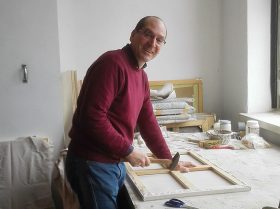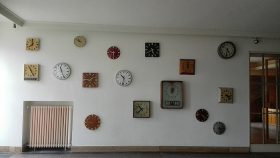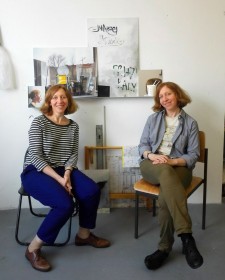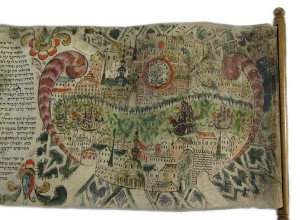Joachim Seinfeld’s HeimatReisen (HomelandTravels)

Joachim Seinfeld at work in his atelier in the former broadcasting station in Berlin; Jewish Museum Berlin, photo: Michaela Roßberg
The wonderful thing about Berlin for me as an historian is that there’s something around every corner waiting to wow me or get my “history heart” to skip a beat. I was able to get to know yet another spot this year when I interviewed Joachim Seinfeld in his atelier in the old broadcasting station in the Berlin Treptow-Köpenick district. We talked about his HeimatReisen (HomelandTravels) project for the art vending machine at the Jewish Museum Berlin (further information on the art vending machine on our website).

The station’s entryway was built with marble tiles from the New Reich Chancellery; Jewish Museum Berlin, photo: Michaela Roßberg
The broadcasting station on Nalepastrasse is a unique place: Beginning in 1956, programming across the former GDR was produced and broadcast from there. The public broadcasting system, established following German reunification, took over this work in 1991 and then, after several changes in ownership, the building became a place for artists from around the world to establish their ateliers.
Joachim, your photo series – available to visitors in the art vending machine – consists of a number of images depicting you in various locations around Germany. Why, of all your work, these images for the vending machine?
In 2006, I did a photo series about Poland. In 2011, I thought to do something similar about Germany. So I wanted to do it anyway, and I chose the images most interesting to me. → continue reading
A Conversation with the Artists Maria und Natalia Petschatnikov
The end of May, as the first palpable rays of sun shone in Berlin, offered the perfect occasion for an outing to Berlin’s Kreuzberg neighborhood. There the artists Maria and Natalia Petschatnikov showed me their atelier and told me about “Sparrows” and “4 Euros,” the two objects they made for the Jewish Museum Berlin’s art vending machine. They also talked about their current projects and responded with good humor to all of my questions above and beyond the subject of art.

Maria (left) and Natalia Petschatnikov in front of part of their project “Berlin & Berlin”, 2015
© and photo by Michaela Roßberg
Michaela Roßberg: You work together and you’re twins – identical twins. What is it like to work so closely? How do you develop ideas and work on projects? And does one or the other of you start with an image of the finished work in mind?
Maria: We do a lot through dialogue. It isn’t that one of us has an idea and, once a project is finished, could say: “That was my idea.” Our work emerges from a joint process. For instance, we walk through the city and see interesting things that get us thinking. We talk about them, and together, start forming ideas. → continue reading

Detail of a Megillah, Germany, 18th century
© Jewish Museum Berlin. Photo: Michaela Roßberg
Today, 16 March, Jewish communities are celebrating Purim. On this holiday, the biblical Book of Esther is read aloud in synagogue. In keeping with tradition, the story of Esther—who saves the Jewish people in the Persian Empire from destruction by Haman, the king’s highest-ranking official—is read not from a book but from a parchment scroll. Commenting on the (Hebrew) reading, noisy hoots and rattles are sounded. (Alternative customs are described in our blog text for last year’s Purim).
Numerous Esther scrolls are currently in the custody of the Jewish Museum. The 32 works on loan will be on display along with other historical manuscripts from 4 April 2014, in the special exhibition “The Creation of the World. Illustrated Manuscripts from the Braginsky Collection.” → continue reading



